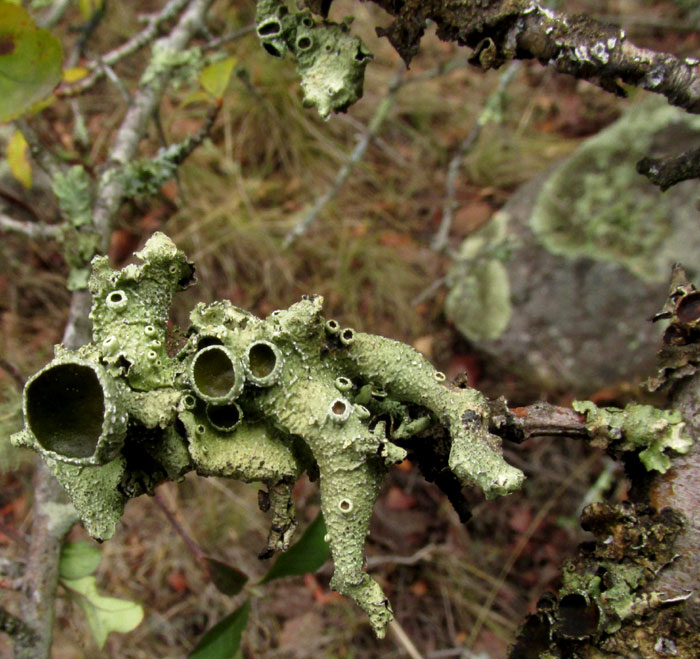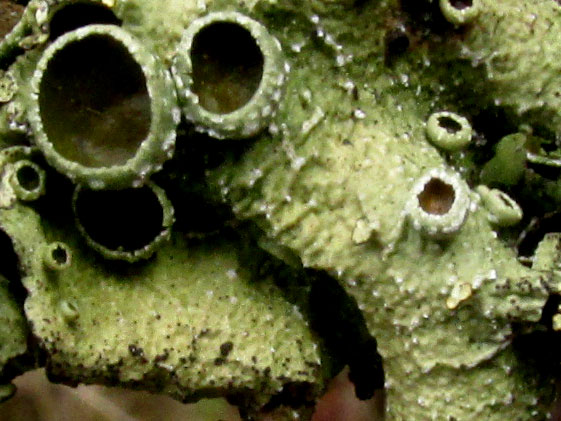Excerpts from Jim Conrad's
Naturalist Newsletter
entry from field notes dated July 3, 2022, taken on the eastern lower slope of Cerro de la Cruz, at an elevation of ~2700m (~8850 ft), just south of the community of El Pinar, Amealco de Bonfil, Querétaro, MÉXICO, (~N20.17°, ~W100.17°)
FRUITING SPECKLED GREENSHIELD LICHEN

At the edge of the oak forest mantling the steep, lower eastern slope of Cerro de la Cruz, where just enough sunlight from the open field enabled grass to grow on the forest floor, the above foliose lichen was at home on an oak twig. Usually, besides admiring them, I just pass by lichens, assuming I won't be able to identify them. However, this species with its large spore-producing cups, or apothecia, was so distinctive that maybe I had a chance, plus the species was similar to a common one in parts of the US, the Eastern Speckled Shield Lichen. The surface of that species, though, is gray, while this one on Cerro de la Cruz had a slightly greenish hue. Apparently in this species' body -- as with all lichens consisting of intermeshed fungus and algae and/or cyanobacteria cells living symbiotically -- there are more photosynthesizing green alga and/or cyanobacteria cells.
In this species, the spore-producing apothecia were particularly large, but otherwise they were normal spore-producing bodies. In a lichen body, it's the fungus who produces the spores, and you can see in the picture that the interior of the apothecia, where the spores are produced, looks fungusy. To see details important for identification, the body must be looked at closer:

The body was densely covered with tiny, white spots called pseudocyphellae, which help with gas exchange in the lichen body similar to how stomata and lenticels help trees "breathe." Pseudocyphellae are thought to be especially helpful to lichens in temperate environments, such as our high elevation here in the central uplands. Many lichen bodies don't possess pseudocyphellae, so this is an important fieldmark. Also, in some lichen genera the pseudocyphellae gather to form a network pattern or discoloration, but on our lichen, they occur separately from one another, or gather in small, wrinkle-like clusters.
The above picture also reveals even smaller specks that are black, known as pycnidia. As the lichen's apothecia produce spores through the sexual process, pycnidia produce spores asexually. Pycnidia are very small cavities in the lichen's body. Asexually produced spores, pycnidiospores, are released through a hole in each pycnidia's top. Any new lichen developed from a pycnidiospore is a genetic clone of the parent. Still, very often pycnidiospore reproduction is more responsible for certain lichens populations than sexual reproduction. Many lichen genera bear no pycnidia, so their presence also is an important field mark.
The similar North American lichen mentioned above, the Eastern Speckled Shield Lichen, is a member of the genus Punctelia. With this in mind I looked for a treatment of Mexico's species of Punctelia, and felt lucky to find the excellent 2009 work by Isela Álvarez and Laura Guzmán-Dávolos entitled "Flavopunctelia y Punctelia (Ascomycetes liquenizados) de Nueva Galicia, México." Using that publication's identification keys, I was led to FLAVOPUNCTELIA PRAESIGNIS, sometimes known as the Fruiting Speckled Greenshield.
Flavopunctelia praesignis occurs on the bark of hardwoods such as oaks, acacias and cherry trees, and conifers such as pines, junipers and firs, in the mountains at elevations of about 1200-2600m (3900-8600 feet), from upland areas of the southwestern US south into Guatemala, and scattered elsewhere, especially in South America and apparently Africa. Fungal spores and dried algae cells can travel great distances on winds.
For me in the field working with fresh material and an old man's eyes, the main field marks of the species were the body's slightly green color, the numerous and large (up to 10mm, 13/32inch wide) apothecia, the many scattered pseudocyphellae and many black pycnidia. Still, at first glance, I'd thought it might be the Eastern Speckled Shield Lichen, remembered from North America.
To identify lichens, you need to master just a few special terms, especially those of "pseudocyphellae" and "pycnidia." Beyond that, lichen identification is a particular pleasure not only because of the surreal forms and unexpected colors and tiny details, but also because there's a website, LichenPortal.Org, that's so well illustrated and informative, and has such wonderful maps showing where the species has been documented, that it's just fun to use. You may enjoy looking at that website's Flavopunctelia praesignis page. Be sure to click on the Interactive Map, then on one of the blue dots (zoom in to see them all ), and see the who, where, when and other information about that specific collection.
I use the website mainly to verify identifications made using other sources, such as the Álvarez and Guzmán-Dávolos study. If such studies aren't available, then it comes down to doing image searches on keywords such as "lichen crustose Mexico," then browsing among the many, many resulting thumbnails.